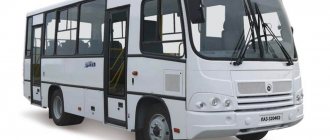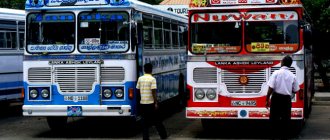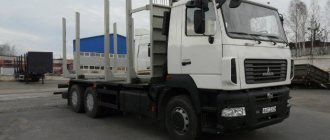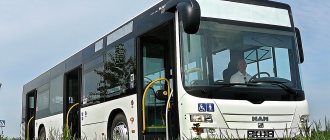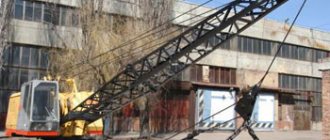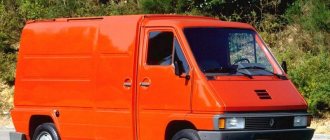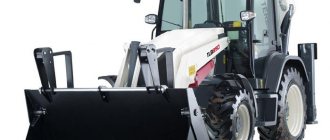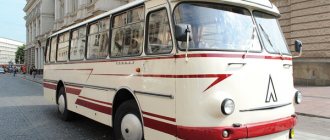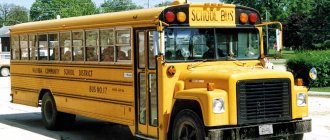Neoplan Cityliner bus. Neoplan Photos
Neoplan Cityliner is a line of one-and-a-half-decker tourist buses produced since 1971. The model range includes several variants of machines that appeared in different years and meet the highest current standards.
Story
There is constant debate among automotive experts and journalists as to when to start counting the birth of the model . From the appearance of the idea, the first concept, the first exploratory layout, prototype, production line or its worldwide presentation? It would seem from the first point. But sometimes decades pass between the first and last events. The same is true for other periods. That’s why today anniversaries are celebrated, starting from the worldwide presentations of the car or its first official displays to the general public. Therefore, there is debate about the date of birth of the epoch-making Cityliner.
Neoplan N116 Cityliner bus (1977-1979). Photo Wikipedia
Neoplan founder Gottlob Auwerter personally began sketching the world's first "Hochdecker" (high-deck) in 1963. His eldest son Conrad graduated from the University of Hamburg in 1961, where he met a talented specialist in many fields, especially in the field of design technology and vehicle design, Bob Lee. Conrad and Bob's graduation project was an unusual bus at the time called the Hamburg. The bus was first demonstrated in 1961.
The one-and-a-half-story tourist bus “matured” with incredible difficulties. Despite its advantages, Gottlob was afraid of one thing - the habit of the average person to an already established scheme. It's not that tall single-decker buses with large luggage compartments didn't exist at all. There were, and quite a few. But... In the hands of Auwerter, the birth of a completely new class began - the class of one-and-a-half-decker buses, that is, between single-decker and double-decker buses, the brilliant strategist saw a huge empty niche . In the end, a decision was made, a suitable option was selected, and work began on its production and subsequent testing.
At the Internationalen Omnibuswoche' 1971 (International Bus Week 1971) in Monaco, a new class of bus appeared for the buyer - a one-and-a-half-story bus from Neoplan called Cityliner . The bus made an indelible impression on the potential buyer and the ordinary amateur.
A bus with a length of 12,000 mm, a height of 3450 (and later - 3550) and a width of 2500 with a base of 5650 for 52 passengers , even standing still, gave the impression of swiftness due to the massive front pillar very inclined forward, which is also a power element on the outside lined with unpainted stainless steel sheet. Next came barely noticeable inter-window pillars with the same slope. Under the large curved side windows there was a row of narrow windows, increasing the tourist’s visibility to the sides. The engine was a 240-horsepower 6-cylinder Henschel, and later a whole range of Mercedes-Benz engines.
The “front” was also unusual: the windshield consisted of two massive horizontal parts (the top panoramic one was also double, but this is almost invisible), the same stainless steel, rectangular, vertical headlights and the famous “Neo-Plan” bumper bracket, which defined corporate identity for many years to come. What's new on this bus? How many prototypes were there before and after it? The automotive press of those years called beautiful cars made in a single copy (“prototype”). The first Cityliner was also called a prototype. But more attentive journalists were able to discern in it a simple pre-production version of an ordinary tourist bus, but with an unusual layout.
There have never been serial “tourists” with a wardrobe and toilet located not in the cabin, but under it; never before has the passenger compartment been so actively separated from the driver’s workplace. The air channels laid along the entire cabin looked like a curiosity. The front air suspension soon became independent with active control and automatic pressure control in the air cylinders.
Neoplan N116 Cityliner bus (1981-1988). Photo Wikipedia
For the first time, Bob Lee calculated the spatial frame on a computer, and based on the results of the calculations, a mathematical model of it was already built, down to specific details. Later, a similar method was called the finite element method . This made it possible to build a body with less metal consumption, but more durable.
The row of side windows soon disappeared, and three-axle options appeared. One of them is a triaxial one with a length of 14,110 mm. – was built for one of the Swedish travel companies. It carried 60 passengers and had a total weight of 22,000 kg. A record was set for Europe - the longest single vehicle! A little later, a 14,380 mm bus was released. with a single upper windshield, the final version of the side glazing and also with vertically positioned headlights. There is another record! . And a little later - in 1975 - another one, but already 15 meters long.
For some time, Cityliner changed externally and internally very often, the process of formation was underway. During the first couple of years of its existence, about thirty variants appeared, and not a single one similar to the previous one. But by 1973 everything fell into place. The process of formation was completed, and the appearance, apparently, forever became the standard of bus beauty.
In 1976, articulated Cityliner called the Highliner , but only six copies were produced.
The first Cityliner was truly revolutionary, and Neoplan forever secured its role as a leader in the bus industry, both in terms of construction and design. There is plenty of evidence of this. For example, a bumper in the form of an inverted bracket literally a year later appeared on all continents where buses were produced. Even the independent ]Mercedes[/anchor] uses this technique these days!
Each model had a lot of modifications , differing from each other in length, height, number of seats, interior layout, engine brands and their power.
However, some popular models/modifications, as well as information about modern options, are presented below.
China takes the lead
In Asia, the Iranian Iran Khodro, Indian Ashok Leyland, Hinopak, Sutlej and the Turkish company BMC Power Motor ve Kontrol Teknolojileri A.Ş have mastered the production of passenger equipment for airports. The BMC Neoport bus is built according to classic patterns: length 14 m, width 3 m, modern engine and automatic transmission. The external and internal design of the new product has been well-developed. The model's premiere took place in October 2022 at the Busworld Europe exhibition in Kortrijk, Belgium.
Well, it would be strange if platform buses were not produced in Chinese factories. At first, local products (Beifang, Jinghua) were used only for domestic needs, which was due, among other things, to the intensive growth of air traffic in the country. Now Chinese companies have begun to squeeze classic manufacturers of airfield equipment - the same Cobus, for example.
One of the leaders in the Asian market is Xinfa Airport Equipment Ltd, which offers several models of Abus apron buses, differing both in technical characteristics and in design and functionality. For Russian consumers, these models are sold under the indexes Abus 6240, Abus 6270 and Abus 6300. The last three digits again indicate the width of the body, this time in centimeters.
The XMQ6139B airport bus is manufactured under the King Long brand. At the aforementioned Busworld Europe 2017 exhibition, specialists from King Long United Automotive Industry Co., Ltd showed a new model XMQ6140ABD4, built on a three-axis design and powered by batteries. The high-capacity apron electric bus was one of the most unique exhibits at the exhibition, and the fact that its appearance went virtually unnoticed by the press can probably only be explained by the abundance of premieres at this award-winning event and the focus of specialized publications on new products presented by the main European brands.
China Youngman Automobile Group Co., Ltd, being an official partner of the European holding MAN Truck & Bus AG, which owned the rights to use the Neoplan brand, naturally also could not ignore such an original and promising development as apron passenger equipment. The Youngman JNP6140 bus is a licensed copy of the 14-meter Neoplan Airliner N9122. So far, mass production of this particular model is known, but, undoubtedly, our eastern neighbors will eventually create (if they have not already created) new modifications of airfield buses, based on their own developments.
Another Chinese “apron” is Yutong ZK6140BD from Zhengzhou Yutong Group Co., Ltd. The Yutong brand is widely known in Russia, and this model is already offered by dealers of the Chinese company, but there is no information yet whether Yutong ZK6140BD buses operate anywhere in our country. Judging by the statistics available on amateur websites dedicated to buses, Russian airports prefer to purchase mainly Minsk or German-made equipment, i.e. MAZ-171 and Cobus 2700 / 3000 apron buses.
The author thanks Denis Dementyev and Dmitry Gladky for their assistance in preparing the material.
Part 1 Part 2
Model range: N116, N1116 and others
First generation (N116, N114; 1971-1980). At the 20th International Bus Exhibition in Monaco in 1971, Neoplan presented the Cityliner with the index N116. The two-axle bus was characterized by curved side windows, an engine located in the rear, high seating for passengers, and the interior located above the luggage compartments, the volume of which was more than ten cubic meters. The bus had a kitchen and toilet. The bus was equipped with a diesel engine with a volume of 11.94 liters and a power of 203 hp. The length was 12000 mm, width 2500, height 3100, number of seats - 52.
Neoplan N116 Cityliner bus (1993-2000). Photo Wikipedia
In 1973, another modification of the Cityliner was introduced with a higher body height - 3.55 m. The model with three axles was offered with air conditioning and double glazing.
Since 1978, shorter Cityliners with the designation N114 were produced for Belgium and the Netherlands, which had only five rather than six side windows. The vehicles also had a rounded stainless steel bumper and an emergency exit.
In 1979, the Cityliner family was modernized, in particular, the steel bumpers were replaced with black plastic ones.
Second generation (N116, N112, N118; 1981-1993). In 1981, the Neoplan Cityliner changed. Changes affected the front part, the model acquired new wheel arches, etc.
In 1986, Neoplan began production of the 13.7-meter three-axle Cityliner for the American market, produced at the Lamar plant (USA).
In 1988, along with the updated main model N116, a short version of the Cityliner with the index N112 was introduced for the Japanese market.
Third generation (N116, N118; 1991-2000). In 1990, the Cityliner line was expanded to include a version of the high Cityliner, which was 16 cm higher, and the luggage compartment was increased to 15.6 cubic meters.
At the beginning of 1992, the three thousandth Cityliner was produced. Further measures to modernize the model were carried out in 1993-1994: the instrument panel and air conditioning system were completely redesigned, combined with optimization of the model’s exterior. The first cars were built with a length of 12 meters, N118/3H - 15 meters.
In 1996, the Cityliner production program was expanded - a three-axle 13.7-meter version (N116/3HL) was introduced.
In 1998/1999, licensed construction of the Cityliner began in South Africa and then in China.
Fourth generation (N1116; 2000-2006). In 2000, the Cityliner 2000 was introduced with a redesigned front end.
In 2001, after the MAN AG concern bought out the Neoplan company, the Cityliner model was updated again, it received new headlights, a rear window resembling a heart shape, and round wheel arches. Buses began to meet Euro-3 environmental standards. The line was continued with three new options (Cityliner 12 meters long - N1116, Cityliner 12 meters with three axles - N1116/3; Cityliner 13.7 meters with three axles - N1116/3HL).
Neoplan Cityliner bus N1216. Photo Wikipedia
In 2003, Neoplan introduced a special edition of the Cityliner model with increased comfort. Cityliner HC is 12.84 meters long with a three-axle body.
Fifth generation (N1216, N1217, N1218, since 2006). In 2006, on the 35th anniversary of the launch of the Cityliner, Neoplan introduced a new generation of the bus. The first model of this generation, Neoplan Cityliner N1216 HD (internal designation P14), has two axles and a length of 12.5 meters. The bus is a completely new development and is built on the Starliner II chassis.
The Neoplan 1216 bus has many advantages and additional features. ABS, ASR, ESP, ECAS systems, it is also possible to install a maximum speed limiter device. The bus has an unusual and futuristic design. The advantages also include a stainless steel body, increased transportation comfort, and air suspension, which eliminates road surface defects. The bus has balanced axle loads; due to the large load on two axles, a third additional one was built in. There are a lot of places in the back where you can store a variety of equipment. The advantages in terms of the safety of the model include seat belts installed on all passenger seats, the steps are covered with pile.
In 2007, Neoplan Cityliner N1217 HDC (internal designation P15) was introduced, having three axles and 12.99 meters in length.
In the fall of 2007, the three-axle Neoplan Cityliner N1218 HDL (internal designation P16), 13.99 meters long, was introduced.
Description and device
As of 2022, the company offers three modifications: Cityliner, Cityliner C and Cityliner L, which have the following characteristics:
- Body dimensions, mm. 12240/12990/13399x25503720.
- Number of seats. Up to 51+1+1/up to 59+1+1/up to 63+1+1.
- Turning diameter, mm. 21140/22494/22354.
- Wheelbase, mm. 6060/6200/6550.
- Luggage compartment volume, cubic meters Up to 12.2/up to 13.1/up to 14.1.
- Engine model. MAN D2676 LOH.
- Working volume, l. 12.419.
- Engine power for each modification can be 316 kW (430 hp)/346 (470)/346 (470) or 346 (470)/375 (510)/375 (510).
- The maximum torque for each modification can be 2200 Nm/2400/2400 or 2400/2600/2600.
- Checkpoint. MAN TipMatic, 12-speed automatic transmission with EasyStart function; 6-speed manual transmission (420 hp only); 6-speed automatic transmission.
- Front axle. Multi-link axle with independent wheel suspension and stabilizer.
- Rear axle. MAN hypoid axle with four-link steering suspension system.
Buses, regardless of modification, have the following features:
Interior of the Neoplan Cityliner bus. Neoplan Photos
The design of long-distance buses is a unique, complete combination of elegance, harmony and convenience. From the exterior to every detail of the interior, a comfortable atmosphere reigns on board a Cityliner bus – even on long journeys.
- Classic elegance. With its futuristic dome glazing, panoramic windows and unusual paint finish, the Cityliner takes full advantage of the award-winning Sharp Cut design.
- Stunning views. Wide windows, from the panoramic dome to the rear quarter glass, provide passengers with stunning views and light inside the cabin.
- Impressive visibility. The all-LED headlights with black bezels are an eye-catcher, while the Angel Eyes ring LED running lights ensure optimal visibility and visibility of the bus on the road.
- High-quality materials, perfect execution: Neoplan interior . Mesmerizing harmony. The noble design, thought out down to the smallest detail, gives the Cityliner an incomparable elegance: the floors, seats and ceiling are made of the most refined materials.
- Ride in comfort. Wide entrances with premium design invite passengers to enter the cozy cabin and take their seats in comfortable seats.
Comfort. In the Cityliner, your passengers enjoy a cozy atmosphere, designed down to the smallest detail. This is greatly facilitated by numerous premium-level additions: from a mobile cafe to an entertainment system. For the driver, Cityliner provides an exclusive workplace. The spacious driver's seat is also superbly equipped. Sit in a spacious, comfortable seat with precise adjustment. From here you can see all the instruments, indicators and switches, ergonomically located, with excellent visibility and easy reach.
“Limousine” among tourist buses demonstrates the best results when it comes to technology . The Cityliner uses only the highest class technologies - from the engine, transmission technology and technical solution of the bus to the optimization of dimensions and space utilization.
Premium reliability and efficiency thanks to driver assistance systems. In the Cityliner, passengers feel as comfortable as they are safe. High-performance intelligent systems provide automated safety and optimal driver support. Last but not least, saving fuel and reducing repair costs are important.
Advantages of purchasing books and literature online
The official website of Chitai Gorod Ru, both for users living in the frantic pace of modern life and wanting to spend a minimum of time searching and purchasing the right product, and for those who like a thorough choice. Completing an application will not be difficult for the user: the selected products are sent to the cart, following step-by-step instructions and reporting the address and delivery method takes no more than two minutes and the purchase is sent to the address. The official website has created conditions for every visitor to Read-City for a comfortable purchase, because:
- The work schedule 24 hours a day, 7 days a week allows you to go to the official website of Chitai Gorod Ru and make purchases without limiting your time;
- detailed information about each offer, with customer reviews, helps you decide on the choice of a gift based on interests, for yourself or loved ones;
- over a thousand self-pickup points equipped throughout the country;
- the selected product is delivered free of charge to the Chitai-Gorod delivery point closest to the customer’s place of residence, delivery by courier service or mail is provided;
- Affordable prices and promotional offers set the resource apart, allowing you to save money when purchasing.
